DNA Sequencing Market Size
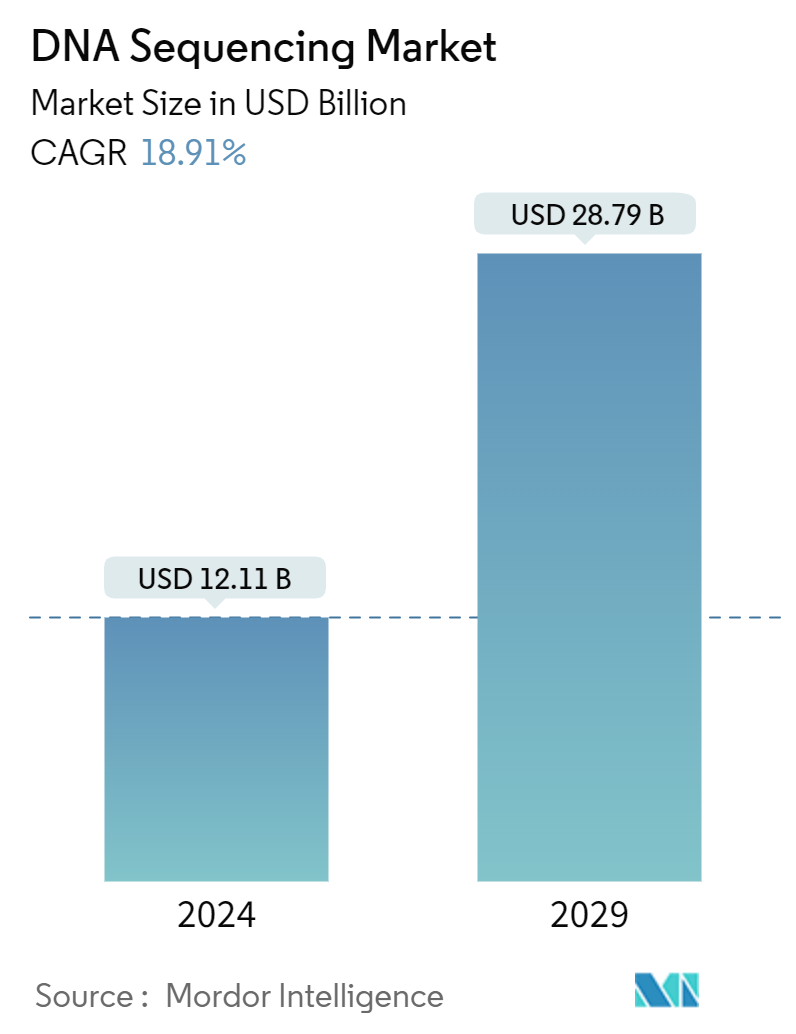
| Study Period | 2019 - 2029 |
| Market Size (2024) | USD 12.11 Billion |
| Market Size (2029) | USD 28.79 Billion |
| CAGR (2024 - 2029) | 18.91 % |
| Fastest Growing Market | Asia-Pacific |
| Largest Market | North America |
Major Players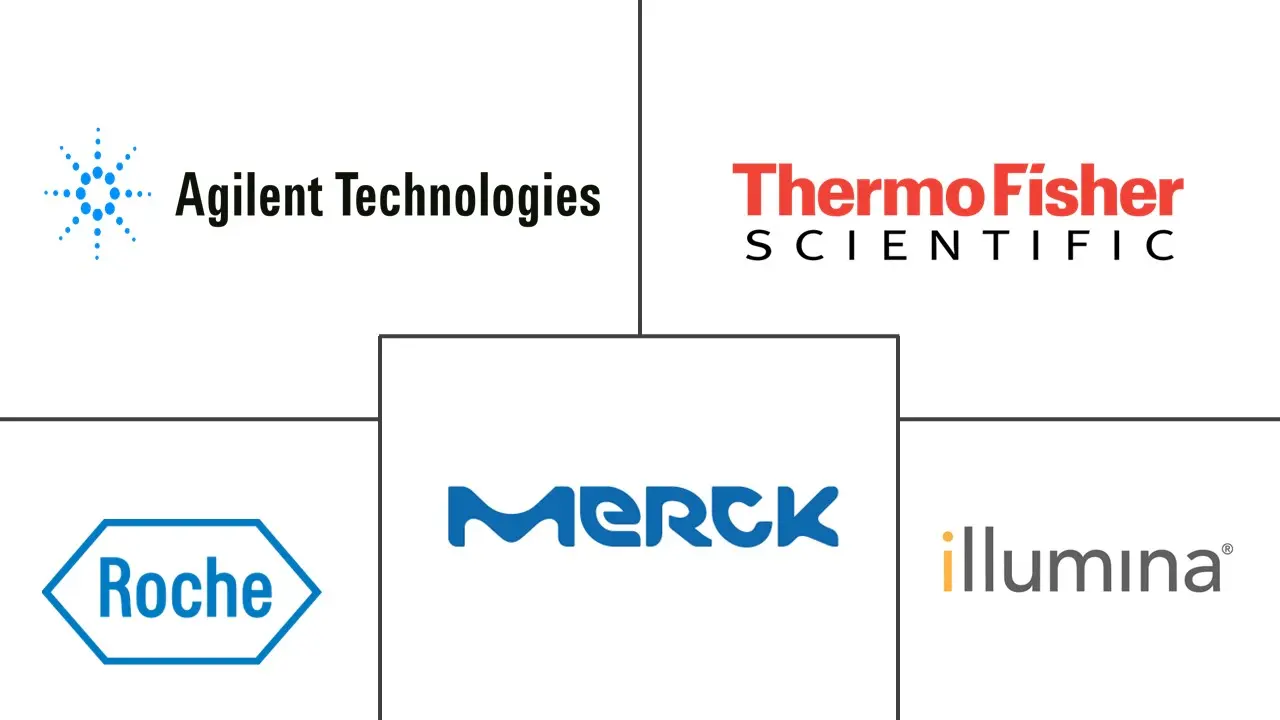
*Disclaimer: Major Players sorted in no particular order |
DNA Sequencing Market Analysis
The DNA Sequencing Market size is estimated at USD 12.11 billion in 2024, and is expected to reach USD 28.79 billion by 2029, growing at a CAGR of 18.91% during the forecast period (2024-2029).
The COVID-19 pandemic had a positive impact on the market studied, as it increased the demand for DNA sequencing technology in the development of therapeutics and diagnostics for COVID-19 infection. For example, in November 2021, the Union Minister of State for Science and Technology India announced that the Department of Biotechnology (DBT) had completed one lakh genome and DNA sequencing for COVID-19 and that five COVID-19 biorepositories with 57,000 samples had been made available to academia and industry for R&D and product development. Hence, owing to the increasing DNA sequencing-based R&D activities in the development of diagnostic tools or effective therapeutics for COVID-19, the market is likely to continue its significant growth during the forecast period.
Certain factors driving market growth include advances in DNA sequencing technology, increased applications in clinical diagnosis and drug discovery, and increased R&D investments. DNA sequencing has applications in diagnostics, personalized medicine, biomarkers, forensics, reproductive health, and other areas. DNA sequencing technology holds great potential in clinical R&D of cancer diagnostics and therapeutics. Recently, next-generation sequencing (NGS) technology has demonstrated its capacity as a high-throughput and affordable approach to identify and characterize clinically actionable genetic variants across numerous genes at an exceptional speed in a single test. According to a research article published in the Journal of Pure and Applied Microbiology in June 2022, DNA sequencing methods have evolved throughout time to be employed in clinical diagnostic laboratories and research labs to produce high-quality results. It aids in the identification of new targets for therapy and diagnosis, broadening the horizon for patient care. Therefore, the increasing application of DNA sequencing in clinical diagnosis and drug discovery is expected to drive market growth over the forecast period.
The technological advancements in sequencing, from 2D sequencing in the 1970s to DNA sequencing, have come a long way. In recent years, platforms such as Illumina/Solexa, ABI/SOLiD, 454/Roche, and Helicos have provided unique prospects for high-throughput functional genomic research. Furthermore, the increased launch of technologically advanced DNA sequencing platforms is expected to propel market growth. For instance, in December 2021, Singular Genomics Systems, Inc. announced the commercial release of the G4, the benchtop sequencer. The NGS platform uses revolutionary high-performance chemistry and advanced engineering to provide precision, flexibility, speed, and power for a variety of applications, including oncology and immunology research.
Moreover, growing R&D activities are expected to raise demand for DNA sequencing due to its role in drug discovery and development. For instance, in July 2022, a genomics startup in California raised USD 600 million in funding to deliver a USD 100 whole human genome using its new high-throughput, low-cost sequencing platform.
Thus, all the above-mentioned factors are expected to propel the growth of the market. However, the interpretation of complex data and the lack of skilled professionals may restrain the market growth over the forecast period.
DNA Sequencing Market Trends
The Next-generation Sequencing Segment (NGS) is Expected to Hold Significant Market Share and Expected to Follow the Same Trend Over The Forecast Period
The NGS segment is being driven by factors such as the increasing applications of NGS, speed, cost, accuracy, efficient replacement of traditional technologies, and drug discovery applications demanding NGS technology. The advantage of this technology is that it is significantly cheaper, quicker, and requires significantly less DNA, which helps in the overall growth of the segment.
There are various technological advancements in the field of medicine that are growing at a rapid pace and have led to the development of personalized medicine. For instance, in October 2022, the CDC provided the American Society for Microbiology (ASM) with funds to provide NGS training. ASM is likely to create and deliver recognized training to educate the clinical microbiology workforce on NGS technology, boost pathogen genomic sequencing capacity, and prepare for the next pandemic using advanced molecular techniques. It is also likely to educate ASM's bioinformatics partners on infectious diseases, allowing them to better comprehend science and technology's influence on public health. Such instances are expected to increase awareness about the NGS, thereby boosting demand for the segment studied.
Furthermore, product launches by the market players is expected to boost the market growth over the forecast period. For instance, in September 2022, Illumina Inc. (ILMN.O) introduced its next-generation NovaSeq X devices, which the company claims can output more than 20,000 entire genomes per year, or 2.5 times that of previous sequencers. Additionally, in July 2021, QIAGEN announced a global strategic alliance with Japan's Sysmex Corporation for the development and commercialization of cancer companion diagnostics, which will leverage both QIAGEN's leadership in this field and Sysmex's Plasma-Safe-SeqS technology for NGS. Hence, owing to the above-mentioned factors, the segment is expected to grow during the forecast period.
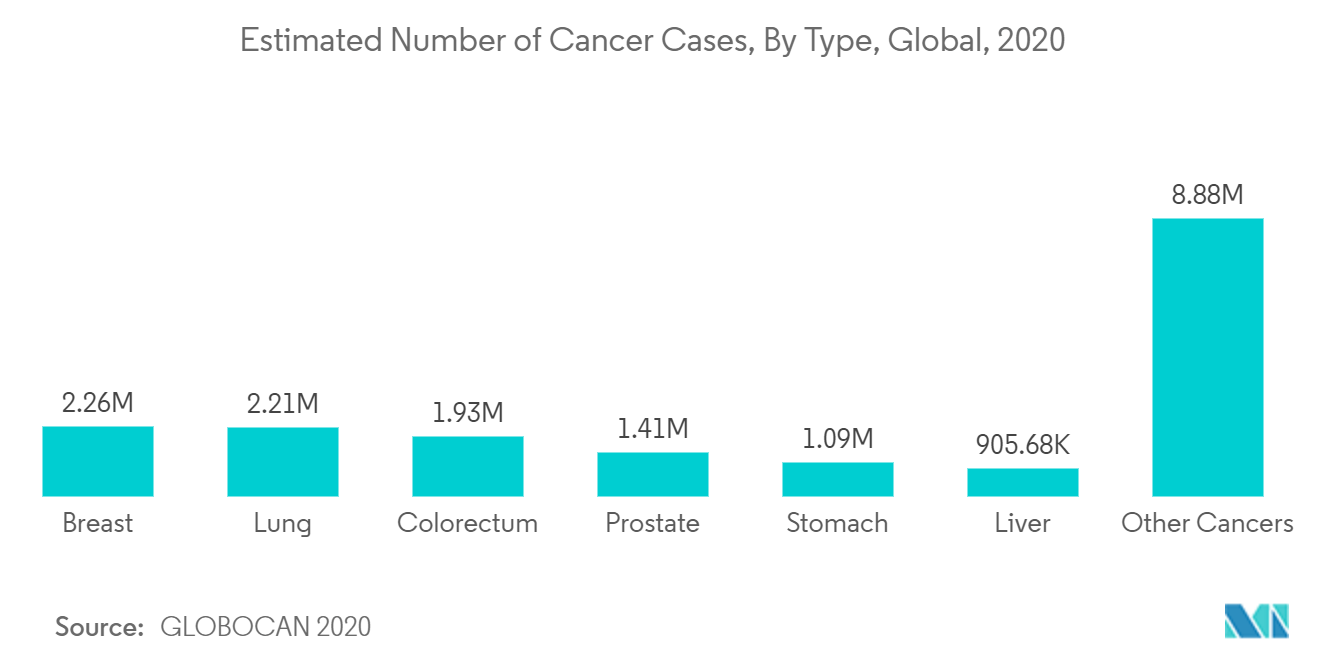
North America Holds a Significant Share in the Market and Expected to do Same during the Forecast Period
North America dominated the market due to an increase in funding and support activities by the government and non-government entities, especially in the United States. The increasing adoption of advanced technologies and favorable support from the government and related policies are the primary driving factors for the DNA sequencing market growth in the country.
Technological advancement in DNA sequencing and product launches is expected to boost the market growth. For instance, in December 2021, Roche launched the AVENIO Edge System to simplify and automate next-generation sequencing sample preparation, reduce human error and advance precision medicine.
Strategic activities by the market players, such as product launches, mergers and acquisitions, and partnerships, are expected to boost the demand for the DNA sequencing market. For instance, in September 2022, Genome Prairie announced the official delivery of next-generation genome sequencing technology to Saskatchewan Polytechnic's BioScience Applied Research Centre (BARC) at its Saskatoon campus in collaboration with PRIESCAN (formerly Western Economic Diversification Canada). The method, which consists of two genomic DNA sequencing equipment, allows researchers to gain a greater understanding of the human biological processes.
Hence, owing to these factors, the DNA sequencing market is expected to be one of the largest in the future.
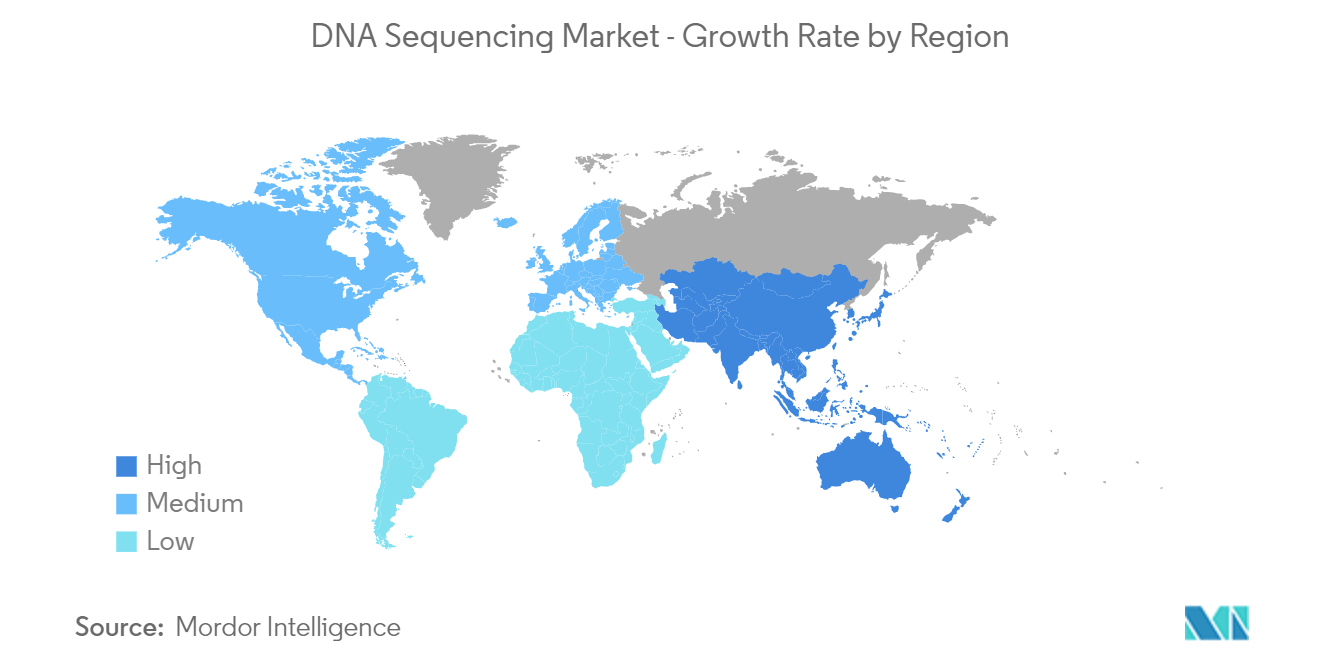
DNA Sequencing Industry Overview
The DNA sequencing market is highly competitive and consists of a few major players. Companies like Agilent Technologies Inc., Bio-Rad Laboratories Inc., Danaher Corporation, Eurofins Scientific, F. Hoffmann-La Roche, Illumina Inc., Merck KGaA, Pacific Biosciences of California Inc., PerkinElmer Inc., and Thermo Fisher Scientific Inc., among others, hold substantial shares in the DNA sequencing market. These companies are making efforts to address the rising consumer demand and are significantly investing in production, distribution, and total quality management for the expansion of their portfolios.
DNA Sequencing Market Leaders
-
Merck KGaA
-
Thermo Fisher Scientific, Inc.
-
Agilent Technologies, Inc.
-
Illumina, Inc.
-
F. Hoffmann-La Roche Ltd.
*Disclaimer: Major Players sorted in no particular order
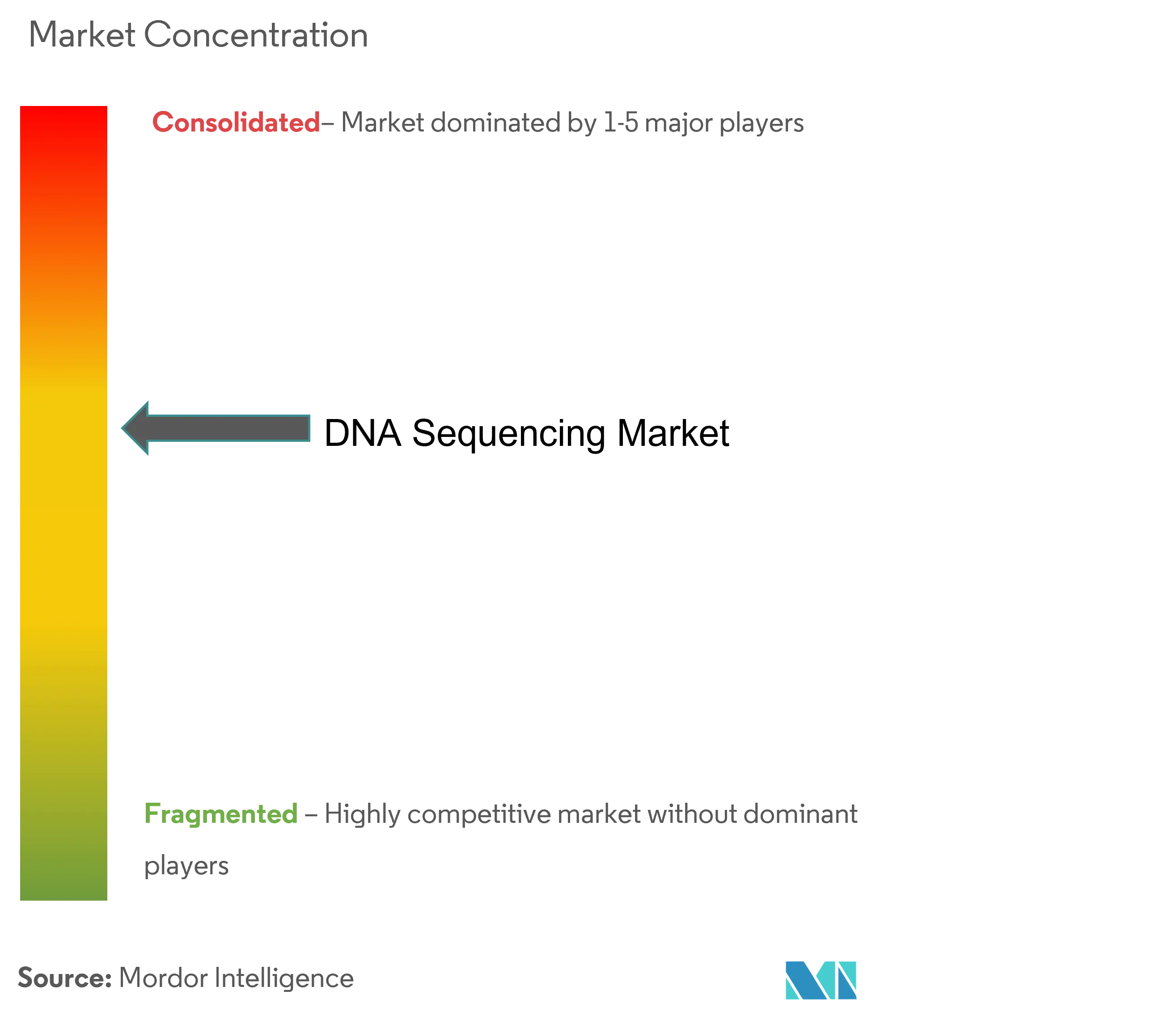
DNA Sequencing Market News
- In October 2022, PacBio has announced the release of two genome sequencing systems, the Revio long-read sequencing system and the Onso short-read sequencing system. Deep-learning methods are also integrated into Revio to detect DNA methylation from regular sequencing libraries.
- In March 2022, Element Biosciences revealed technical details about its long-awaited Aviti DNA sequencer. The new benchtop instrument employs a riff on sequencing-by-synthesis chemistry that Element says reduces reagent usage, leading to costs of approximately USD 7 per Gb.
DNA Sequencing Market Report - Table of Contents
1. INTRODUCTION
- 1.1 Study Assumptions and Market Definition
- 1.2 Scope of the Study
2. RESEARCH METHODOLOGY
3. EXECUTIVE SUMMARY
4. MARKET DYNAMICS
- 4.1 Market Overview
-
4.2 Market Drivers
- 4.2.1 Rise in Technological Advancements in DNA Sequencing
- 4.2.2 Increasing Application in Clinical Diagnosis and Drug Discovery
- 4.2.3 Growing Investments in R&D
-
4.3 Market Restraints
- 4.3.1 Interpretation of Complex Data and Lack of Skilled Professionals
- 4.3.2 Legal and Ethical Issues
-
4.4 Porter's Five Forces Analysis
- 4.4.1 Threat of New Entrants
- 4.4.2 Bargaining Power of Buyers/Consumers
- 4.4.3 Bargaining Power of Suppliers
- 4.4.4 Threat of Substitute Products
- 4.4.5 Intensity of Competitive Rivalry
5. MARKET SEGMENTATION (Market Size by Value - USD million)
-
5.1 By Product Type
- 5.1.1 Instruments
- 5.1.2 Consumables (Kits and Reagents)
- 5.1.3 Other Product Types
-
5.2 By Sequencing Type
- 5.2.1 Sanger Sequencing
- 5.2.2 Next-generation Sequencing
- 5.2.3 Other Sequencing Types
-
5.3 By Application
- 5.3.1 Diagnostics
- 5.3.2 Personalized Medicine
- 5.3.3 Other Applications
-
5.4 By End User
- 5.4.1 Hospitals and Healthcare Organizations
- 5.4.2 Academics and Research Institutions
- 5.4.3 Pharmaceutical and Biotechnology Companies
- 5.4.4 Other End Users
-
5.5 Geography
- 5.5.1 North America
- 5.5.1.1 United States
- 5.5.1.2 Canada
- 5.5.1.3 Mexico
- 5.5.2 Europe
- 5.5.2.1 Germany
- 5.5.2.2 United Kingdom
- 5.5.2.3 France
- 5.5.2.4 Italy
- 5.5.2.5 Spain
- 5.5.2.6 Rest of Europe
- 5.5.3 Asia-Pacific
- 5.5.3.1 China
- 5.5.3.2 Japan
- 5.5.3.3 India
- 5.5.3.4 Australia
- 5.5.3.5 South Korea
- 5.5.3.6 Rest of Asia-Pacific
- 5.5.4 Middle-East and Africa
- 5.5.4.1 GCC
- 5.5.4.2 South Africa
- 5.5.4.3 Rest of Middle-East and Africa
- 5.5.5 South America
- 5.5.5.1 Brazil
- 5.5.5.2 Argentina
- 5.5.5.3 Rest of South America
6. COMPETITIVE LANDSCAPE
-
6.1 Company Profiles
- 6.1.1 Agilent Technologies Inc.
- 6.1.2 Bio-Rad Laboratories Inc.
- 6.1.3 Danaher Corporation (Integrated DNA Technologies Inc.)
- 6.1.4 F. Hoffmann-La Roche Ltd
- 6.1.5 Illumina Inc.
- 6.1.6 Merck KGaA
- 6.1.7 PerkinElmer Inc.
- 6.1.8 Thermo Fisher Scientific Inc.
- 6.1.9 QIAGEN
- 6.1.10 Macrogen Inc.
- 6.1.11 Myriad Genetics Inc.
- 6.1.12 Eurofins Scientific
- 6.1.13 Hamilton Thorne Biosciences
- 6.1.14 Pacific Biosciences of California Inc.
- *List Not Exhaustive
7. MARKET OPPORTUNITIES AND FUTURE TRENDS
** Subject To AvailablityDNA Sequencing Industry Segmentation
As per the scope of the report, DNA sequencing is the procedure of determining or identifying the sequence of nucleotides within a DNA molecule. This information is useful for researchers in understanding the type of genetic information that is carried in the DNA, which may affect its function in the body. It can then, in turn, help to detect genetic changes that may be associated with causing certain health conditions. The DNA Sequencing Market is Segmented by Product Type (Instruments, Consumables, and Other Product Types), Sequencing Type (Sanger Sequencing, Next-generation Sequencing, and Other Sequencing Types), Application (Diagnostics, Personalized Medicine, and Other Applications), End User (Hospitals and Healthcare Organizations, Academics and Research Institutions, Pharmaceutical and Biotechnology Companies, and Other End Users), and Geography (North America, Europe, Asia-Pacific, Middle East and Africa, and South America). The report also studies the biopharmaceuticals market in 17 different countries across major regions across the world. The report offers the value (in USD million) for the above segments.
| By Product Type | Instruments | |
| Consumables (Kits and Reagents) | ||
| Other Product Types | ||
| By Sequencing Type | Sanger Sequencing | |
| Next-generation Sequencing | ||
| Other Sequencing Types | ||
| By Application | Diagnostics | |
| Personalized Medicine | ||
| Other Applications | ||
| By End User | Hospitals and Healthcare Organizations | |
| Academics and Research Institutions | ||
| Pharmaceutical and Biotechnology Companies | ||
| Other End Users | ||
| Geography | North America | United States |
| Canada | ||
| Mexico | ||
| Geography | Europe | Germany |
| United Kingdom | ||
| France | ||
| Italy | ||
| Spain | ||
| Rest of Europe | ||
| Geography | Asia-Pacific | China |
| Japan | ||
| India | ||
| Australia | ||
| South Korea | ||
| Rest of Asia-Pacific | ||
| Geography | Middle-East and Africa | GCC |
| South Africa | ||
| Rest of Middle-East and Africa | ||
| Geography | South America | Brazil |
| Argentina | ||
| Rest of South America |
DNA Sequencing Market Research FAQs
How big is the DNA Sequencing Market?
The DNA Sequencing Market size is expected to reach USD 12.11 billion in 2024 and grow at a CAGR of 18.91% to reach USD 28.79 billion by 2029.
What is the current DNA Sequencing Market size?
In 2024, the DNA Sequencing Market size is expected to reach USD 12.11 billion.
Who are the key players in DNA Sequencing Market?
Merck KGaA, Thermo Fisher Scientific, Inc., Agilent Technologies, Inc., Illumina, Inc. and F. Hoffmann-La Roche Ltd. are the major companies operating in the DNA Sequencing Market.
Which is the fastest growing region in DNA Sequencing Market?
Asia-Pacific is estimated to grow at the highest CAGR over the forecast period (2024-2029).
Which region has the biggest share in DNA Sequencing Market?
In 2024, the North America accounts for the largest market share in DNA Sequencing Market.
What years does this DNA Sequencing Market cover, and what was the market size in 2023?
In 2023, the DNA Sequencing Market size was estimated at USD 9.82 billion. The report covers the DNA Sequencing Market historical market size for years: 2019, 2020, 2021, 2022 and 2023. The report also forecasts the DNA Sequencing Market size for years: 2024, 2025, 2026, 2027, 2028 and 2029.
DNA Sequencing Industry Report
The global DNA sequencing products market is poised for significant growth, driven by advancements in sequencing technologies and their expanding applications. The market is segmented by product type, including instruments, consumables, and other product types. Additionally, it is categorized by sequencing type, such as Sanger sequencing and next-generation sequencing, among others. The applications of DNA sequencing are vast, spanning diagnostics, personalized medicine, and other areas. Key end users include hospitals and healthcare organizations, academic and research institutions, pharmaceutical and biotechnology companies, and other entities.
The market analysis indicates a robust market growth trajectory, with North America, Europe, Asia-Pacific, the Middle East and Africa, and South America being the primary geographical segments. Industry reports highlight the importance of market segmentation in understanding the diverse needs and demands within the market. The market overview provides insights into the market size, market share, and the competitive landscape, identifying market leaders and their strategies for maintaining market dominance.
Industry research underscores the significance of market data and market statistics in shaping market predictions and market forecast. The industry outlook is optimistic, with industry trends pointing towards increased adoption of DNA sequencing in various fields. The market review reveals that industry sales are expected to rise, driven by the growing demand for personalized medicine and advancements in sequencing technologies.
Researchers and companies can access a report example and a report PDF to gain a comprehensive understanding of the market value and growth rate. The industry analysis provides valuable industry information, highlighting the key drivers and challenges in the market. As the market continues to evolve, staying informed with industry research and market predictions will be crucial for stakeholders to navigate the dynamic landscape of the DNA sequencing products market.



